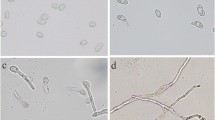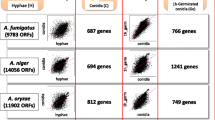Abstract
Trichophyton rubrum is a dominating superficial dermatophyte, whose conidial germination is correlated to pathopoiesis and a highly important developmental process. To investigate the changes of physiology, biochemistry and cytology during the germination, we selected 3364 function identified ESTs from T. rubrum cDNA library to construct cDNA microarrays, and compared the gene expression levels of conidia and germinating phase. Data analysis indicated that 335 genes were up-regulated during the germination, which mainly encoded translated, modified proteins and structural proteins. The constituents of cell wall and cell membrane were synthetized abundantly, suggesting that they are the foundation of cell morphogenesis. The ingredients of the two-component signal transduction system were up-regulated, presuming that they were important for the conidial germination. Genes of various metabolic pathways were expressed prosperously, especially the genes that participated in glycolysis and oxidative phosphorylation were up-regulated on the whole, demonstrating that in the environment with sufficient oxygen and glucose, conidia obtained energy through aerobic respiration. This paper provides important clues which are helpful to understanding the changes in gene expression, signal conduction and metabolism characteristics during T. rubrum conidial germination, and possess significant meaning to the study of other superficial dermatophytes.
Similar content being viewed by others
References
Wen Y M, Lu D Y, He L F. Modern Medical Microbiology (in Chinese). Shanghai: Shanghai Medical University Press, 2000. 677–728
Wang L L, Ma L, Leng W C, et al. Analysis of part of the Trichophyton rubrum ESTs. Sci China Ser C-Life Sci, 2004, 47: 389–395
Borkovich K A, Alex L A, Yarden O, et al. Lessons from the genome sequence of Neurospora crassa: Tracing the path from genomic blueprint to multicellular organism. Microbiol Mol Biol R, 2004, 68(1): 1–108
Galagan J E, Calvo S E, Cuomo C, et al. Sequencing of Aspergillus nidulans and comparative analysis with A. fumigatus and A. oryzae. Nature, 2005, 438: 1105–1115
Chambergo F S, Bonaccorsi E D, Ferreira A J S, et al. Elucidation of the metabolic fate of glucose in the filamentous fungus Trichoderma reesei using expressed sequence tag (EST) analysis and cDNA microarrays. J Biol Chem, 2002, 277(16): 13983–13988
Schena M, Shalon D, Davis R W, et al. Quantitative monitoring of gene expression patterns with a complementary DNA microarray. Science, 1995, 270(5235): 467–470
Kanehisa M, Goto S, Kawashima S, et al. The KEGG resource for deciphering the genome. Nucleic Acids Res, 2004, 32 (Database issue): 277–280
Peng J P, Zhang X B, Yang J, et al. The use of comparative genomic hybridization to characterize genome dynamics and diversity among the serotypes of Shigella. BMC Genomics, 2006, 7: 218
He X P, Zhang B R. Research advancement of ergosterol in microbes. Microbiol Bull (in Chinese), 1998, 25(3): 166
Kasuga T, Townsend J P, Tian C G, et al. Long-oligomer microarray profiling in Neurospora crassa reveals the transcriptional program underlying biochemical and physiological events of conidial germination. Nucleic Acids Res, 2005, 33(20): 6469–6485
Galagan J E, Calvo S E, Borkovich K A, et al. The genome sequence of the filamentous fungus Neurospora crassa. Nature, 2003, 422: 859–868
Lengeler K B, Davidson R C, Souza C D, et al. Signal transduction cascades regulating fungal development and virulence. Microbiol Mol Biol R, 2000, 64(4): 746–785
Calera J A, Zhao X J, Calderone R. Defective hyphal development and avirulence caused by a deletion of the SSK1 response regulator gene in Candida albicans. Infect Immun, 2000, 68(2): 518–525
Brinkman F S L, Macfarlane E L A, Warrener P, et al. Evolutionary relationships among virulence-associated histidine kinases. Infect Immun, 2001, 69(8): 5207–5211
Koretke K K, Lupas A N, Warren P V, et al. Evolution of two-component signal transduction. Mol Biol Evol, 2000, 17(12): 1956–1970
Catlett N L, Yoder O C, Turgeon B G. Whole-genome analysis of two-component signal transduction genes in fungal pathogens. Eukaryotic Cell, 2003, 2(6): 1151–1161
Alex L A, Borkovich K A, Simon M I. Hyphal development in Neurospora crassa: Involvement of a two-component histidine kinase. Proc Natl Acad Sci USA, 1996, 93: 3416–3421
Hohmann S. Osmotic stress signaling and osmoadaptation in yeasts. Microbiol Mol Biol R, 2002, 66(2): 300–372
Author information
Authors and Affiliations
Corresponding author
Additional information
Supported by the National High Technology Research and Development Program of China (Grant No. 2001AA223021) and National Key Technologies R&D Programme (Grant No. 2002BA711A14)
Rights and permissions
About this article
Cite this article
Yang, L., Wang, L., Peng, J. et al. Comparison between gene expression of conidia and germinating phase in Trichophyton rubrum . SCI CHINA SER C 50, 377–384 (2007). https://doi.org/10.1007/s11427-007-0046-9
Received:
Accepted:
Issue Date:
DOI: https://doi.org/10.1007/s11427-007-0046-9




